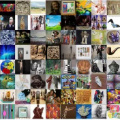The biggest challenge in the application of deep learning to the medical domain is the availability of training data. Data augmentation is a typical methodology used in machine learning when confronted with a limited data set. In a classical approach image transformations i.e. rotations, cropping and brightness changes are used. In this work, a StyleGAN2-ADA model of Generative Adversarial Networks is trained on the limited COVID-19 chest X-ray image set. After assessing the quality of generated images they are used to increase the training data set improving its balance between classes. We consider the multi-class classification problem of chest X-ray images including the COVID-19 positive class that hasn't been yet thoroughly explored in the literature. Results of transfer learning-based classification of COVID-19 chest X-ray images are presented. The performance of several deep convolutional neural network models is compared. The impact on the detection performance of classical image augmentations i.e. rotations, cropping, and brightness changes are studied. Furthermore, classical image augmentation is compared with GAN-based augmentation. The most accurate model is an EfficientNet-B0 with an accuracy of 90.2 percent, trained on a dataset with a simple class balancing. The GAN augmentation approach is found to be subpar to classical methods for the considered dataset.
翻译:机器学习在医学领域应用最大的挑战在于训练数据的可用性。当面临有限的数据集时,数据增强是机器学习中使用的典型方法。在传统方法中,图像转换,如旋转、裁剪和改变亮度是常用的方法。本文使用去年提出的StyleGAN2-ADA的变种GAN方式训练COVID-19胸透图像。经过评估生成的图像的质量,我们使用它们增加训练数据集,改善不同类别之间的平衡性。本研究涵盖了多分类问题,包括COVID-19阳性类,该方案在文献中尚未深入探讨。同时呈现了检测COVID-19胸透图像的迁移学习分类结果。我们比较了几个深度卷积神经网络模型的性能,探讨了传统图像增强,如旋转、裁剪和亮度变化对检测性能的影响,同时与GAN增强方法进行了比较。结果表明,在简单的类别平衡数据集上训练的EfficientNet-B0是最精确的模型,准确率达到90.2%。我们发现对于所考虑的数据集,GAN增强方法不如传统方法。



